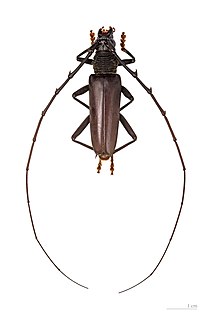
Valgus is a genus of beetles. Most described species are found in Asia, with some reaching into northern Africa and Europe, and three species native to the New World. One species is found in South Africa.
Criodion is a genus of beetles in the family Cerambycidae, containing the following species:

Juiaparus is a genus of beetles in the family Cerambycidae, containing the following species:
Eligmodermini is a tribe of beetles in the subfamily Cerambycinae, containing the following genera and species:
Opacibidion is a genus of beetles in the family Cerambycidae, containing the following species:
Metaleptus is a genus of beetles in the family Cerambycidae, containing the following species:
Metopocoilus is a genus of beetles in the family Cerambycidae, containing the following species:
Elytroleptus metallicus is a species of beetle in the Cerambycidae family. It was described by Nonfried in 1894.
Metaleptus hondurae is a species of beetle in the Cerambycidae family. It was described by Nonfried in 1894.
Metopocoilus giganteus is a species of beetle in the Cerambycidae family. It was described by Nonfried in 1894.
Phaedinus schaufussi is a species of beetle in the Cerambycidae family. It was described by Nonfried in 1890.
Eligmoderma aragua is a species of beetle in the family Cerambycidae. It was described by Martins and Galileo in 2009.
Eligmoderma minuta is a species of beetle in the family Cerambycidae. It was described by Martins and Galileo in 2009.
Eligmoderma politum is a species of beetle in the family Cerambycidae. It was described by Nonfried in 1895.
Opacibidion rugicolle is a species of beetle in the family Cerambycidae. It was described by Nonfried in 1895.
Trypogeus fuscus is a species of beetle in the family Cerambycidae. It was described by Nonfried in 1894.
Acridocera ziczac is a species of beetle in the family Cerambycidae, and the only species in the genus Acridocera. It was described by Jordan in 1903.
Abryna ziczac is a species of beetle in the family Cerambycidae. It was described by Heller in 1924. It is known from the Philippines.
Similosodus ziczac is a species of beetle in the family Cerambycidae. It was described by McKeown in 1942. It is known from Australia.

Zonopterus is a genus of beetles in the family Cerambycidae. Like most members in the tribe Callichromatini, species in the genus are brightly coloured with bands across the elytra. Most species in the genus are restricted to Southeast Asia with one species occurring in the Western Ghats of South Asia which is closely related to the type species Zonopterus flavitarsis from the eastern Himalayas. The genus was named by Frederick William Hope using the Greek roots ζώνη for belt describing the insect as "belted winged".



